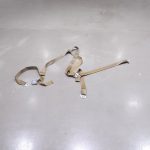“Baden’s pieces forced viewers into awkward situations that expressed his interest in kinesthetics — physical perceptions and the changes that took place in neuromuscular memory as the body moved through the work. In Seat Belts (1969-71) Baden explored the difference between what it felt like to walk around a modified circle while tied with a strap from the waist to the floor and what it looked like it would feel like. He wanted to manipulate the “body prints” of the viewers to alter their perceptions of balance, and creating a new “sensory imprint” was his sculptural aspiration. … Baden’s experiments with sculptural-psychological, body-oriented works in the late 1960s and early 1970s would prove to be highly influential on artists such as Charles Ray and Chris Burden, both of whom were his students.” (Schimmel, Paul. “Leap into the Void: Performance and the Object,” Out of Actions: Between Performance and the Object, 1949-1979. The Museum of Contemporary Art, Los Angeles, 1998. Page 94.)
- Installation view of Mowry Baden, exhibition at the Vancouver Art Gallery, March 9 to June 9, 2019
- Installation view of Mowry Baden, exhibition at the Vancouver Art Gallery, March 9 to June 9, 2019


